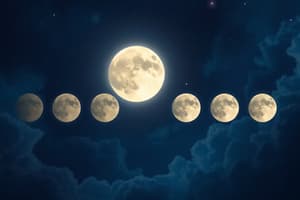Podcast
Questions and Answers
Why does the amount of the Moon's illuminated surface visible from Earth change over the course of a month?
Why does the amount of the Moon's illuminated surface visible from Earth change over the course of a month?
- Clouds and atmospheric conditions on Earth influence the amount of light reflected from the Moon.
- The Moon's surface reflects varying amounts of sunlight due to changes in its composition.
- The Earth's shadow progressively covers different portions of the Moon's surface.
- The Moon's orbit around the Earth and the Earth's orbit around the Sun cause us to see different amounts of the illuminated surface. (correct)
What is the primary source of light that makes the Moon visible from Earth?
What is the primary source of light that makes the Moon visible from Earth?
- The Moon absorbs and re-emits cosmic radiation as visible light.
- The Earth emits light that illuminates the Moon.
- The Moon generates its own light through nuclear fusion.
- The moonlight we see is actually sunlight reflecting off the Moon. (correct)
What is the approximate time it takes for the Moon to complete one orbit around the Earth?
What is the approximate time it takes for the Moon to complete one orbit around the Earth?
- 27.3 days (correct)
- 365 days
- 24 hours
- 30.4 days
During which lunar phase is the Moon not visible from Earth?
During which lunar phase is the Moon not visible from Earth?
What distinguishes the 'waxing' phases of the Moon from the 'waning' phases?
What distinguishes the 'waxing' phases of the Moon from the 'waning' phases?
If you observe a half-illuminated Moon in the night sky, which lunar phase are you most likely seeing?
If you observe a half-illuminated Moon in the night sky, which lunar phase are you most likely seeing?
The time it takes to go from one new moon to the next new moon is slightly longer than the time it takes for the moon to orbit the Earth. Why is this?
The time it takes to go from one new moon to the next new moon is slightly longer than the time it takes for the moon to orbit the Earth. Why is this?
Which of the following statements best describes the Waning Gibbous phase?
Which of the following statements best describes the Waning Gibbous phase?
In the Northern Hemisphere, when do we see the Waxing Crescent phase?
In the Northern Hemisphere, when do we see the Waxing Crescent phase?
Which phase comes directly after the Full Moon in the lunar cycle?
Which phase comes directly after the Full Moon in the lunar cycle?
If tonight you see a crescent moon with the illuminated portion on the left side, what phase is the moon in, assuming you are in the Northern Hemisphere?
If tonight you see a crescent moon with the illuminated portion on the left side, what phase is the moon in, assuming you are in the Northern Hemisphere?
Between which two phases does the Waxing Gibbous moon appear?
Between which two phases does the Waxing Gibbous moon appear?
If tonight you see a Third Quarter moon, approximately how many days until the next New Moon?
If tonight you see a Third Quarter moon, approximately how many days until the next New Moon?
Assume the moon is in the Waning Gibbous phase. Order the following phases that will occur in order: Third Quarter, New Moon, Full Moon.
Assume the moon is in the Waning Gibbous phase. Order the following phases that will occur in order: Third Quarter, New Moon, Full Moon.
On average, why is the time from New Moon to New Moon longer than the Moon's orbital period around Earth?
On average, why is the time from New Moon to New Moon longer than the Moon's orbital period around Earth?
The amount of the Moon we see illuminated changes because we view the Moon from Earth. How does the Moon's actual shape change throughout the month?
The amount of the Moon we see illuminated changes because we view the Moon from Earth. How does the Moon's actual shape change throughout the month?
You observe a half moon that is illuminated on the left side. Assuming you are in the Northern Hemisphere, which of the following phases will be visible next?
You observe a half moon that is illuminated on the left side. Assuming you are in the Northern Hemisphere, which of the following phases will be visible next?
What conditions are necessary for us to observe 'moonlight' on Earth?
What conditions are necessary for us to observe 'moonlight' on Earth?
How does the appearance of the Moon change from one night to the next during the Waxing Crescent phase?
How does the appearance of the Moon change from one night to the next during the Waxing Crescent phase?
What relative positions of the Sun, Earth, and Moon result in a 'New Moon'?
What relative positions of the Sun, Earth, and Moon result in a 'New Moon'?
Flashcards
What is moonlight?
What is moonlight?
Sunlight reflected off the Moon's surface.
What are the Moon's phases?
What are the Moon's phases?
The different shapes of the Moon visible at different times.
Why do lunar phases occur?
Why do lunar phases occur?
The Moon orbits Earth, and Earth orbits the Sun.
What happens during the New Moon phase?
What happens during the New Moon phase?
Signup and view all the flashcards
What is the Waxing Crescent phase?
What is the Waxing Crescent phase?
Signup and view all the flashcards
What is the First Quarter phase?
What is the First Quarter phase?
Signup and view all the flashcards
What is the Waxing Gibbous phase?
What is the Waxing Gibbous phase?
Signup and view all the flashcards
What is the Full Moon phase?
What is the Full Moon phase?
Signup and view all the flashcards
What is the Waning Gibbous phase?
What is the Waning Gibbous phase?
Signup and view all the flashcards
What is the Third Quarter phase?
What is the Third Quarter phase?
Signup and view all the flashcards
What is the Waning Crescent phase?
What is the Waning Crescent phase?
Signup and view all the flashcards
What cycle causes the phases of the Moon?
What cycle causes the phases of the Moon?
Signup and view all the flashcards
How long does it take the Moon to orbit Earth?
How long does it take the Moon to orbit Earth?
Signup and view all the flashcards
How long does it take to go from one new moon to the next?
How long does it take to go from one new moon to the next?
Signup and view all the flashcards
Study Notes
- Moonlight on Earth is sunlight reflected from the Moon's grayish-white surface.
- The Moon would be completely dark without the Sun.
- "Moonlight" is sunlight reflecting off the Moon's surface.
- The amount of the illuminated Moon varies throughout the month, creating what are called lunar phases.
- Lunar phases are created because the Moon orbits Earth, which orbits the Sun.
Lunar Phases
- The Moon's appearance changes throughout the month, from a narrow crescent to a bright circle.
- The different shapes of the Moon are called phases.
- The Moon's actual shape does not change.
- Earth's view of the Moon changes, based on its position in orbit around the Earth.
- The Moon displays 8 phases as it moves through its cycle each month.
- The Moon takes 27.3 days to orbit Earth.
- Sunlight takes 29.5 days to travel from one new moon to the next.
Lunar Phase Names
- New: The Moon is not visible during a new moon.
- Waxing Crescent: A thin crescent of light appears on the right side in the Northern Hemisphere.
- First Quarter: Half of the Moon is visible.
- Waxing Gibbous: The phase between a half moon and a full moon (waxing means it is getting bigger).
- Full: The entire Moon is illuminated.
- Waning Gibbous: The phase between a full moon and a half moon (waning means it is getting smaller).
- Third Quarter: Half of the Moon is visible, opposite side as illuminated in the first quarter moon.
- Waning Crescent: A thin crescent of light appears on the left side in the Northern Hemisphere.
Studying That Suits You
Use AI to generate personalized quizzes and flashcards to suit your learning preferences.




